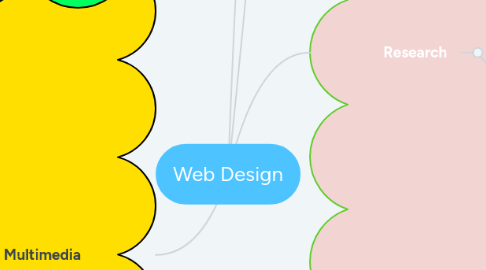
1. Multimedia
1.1. "Multimedia is the use of a computer to present and combine text, graphics, audio, and video with links and tools that let the user navigate, interact, create, and communicate." (University of Delaware, Defining Multimedia, n.d.)
1.2. Web 2.0
1.2.1. "The Web will be understood not as screenfulls of text and graphics but as a transport mechanism, the ether through which interactivity happens" (p. 221). DiNucci, Darcy (April 1999). "Fragmented Future" (PDF). Print Magazine. 53 (4): 221–222.
1.3. Usability
1.3.1. Navigating the multimedia product is a challenging process. "The student has [...] to deal with a double learning process: on the one hand s/he has to learn how to interact with the system, on the other hand s/he has to acquire new and likely difficult concepts" (p. 38). Parlangeli, O., Marchigiani, E., & Bagnara, S. (1999). Multimedia systems in distance education: effects of usability on learning. Interacting with computers, 12(1), 37-49.
1.4. Accessibility
1.4.1. Universal Access focuses on bridging the gap between physical and digital access to everyday products. "In the field of education, the problem of the accessibility of ICT products is considered very important: accessible information technologies can facilitate students’ independent learning and information retrieval (e.g. by accessing multimedia dictionaries, encyclopaedias, websites)" (p. 1). Bocconi, S., Dini, S., Ferlino, L., & Ott, M. (2006). Accessibility of educational multimedia: in search of specific standards. International Journal of Emerging Technologies in Learning (iJET), 1(3).
2. Multiple Intelligences
2.1. "Father of MI" Howard Gardner
2.1.1. Not every person has the same amount or combination of intelligences.
2.2. Types of Intelligences
2.2.1. Linguistic Intelligence
2.2.2. Logical/Mathematical Intelligence
2.2.3. Musical Rhythmic Intelligence
2.2.4. Bodily/Kinesthetic Intelligence
2.2.5. Spatial Intelligence
2.2.6. Naturalist Intelligence
2.2.7. Intrapersonal Intelligence
2.2.8. Interpersonal Intelligence
3. Research
3.1. Cognitive Load Theory
3.1.1. "CLT is concerned with the instructional implications ofthis interaction between information structures and cognitivearchitecture" (p. 2). Paas, F., Renkl, A., & Sweller, J. (2003). Cognitive load theory and instructional design: Recent developments. Educational psychologist, 38(1), 1-4.
3.1.1.1. Instrinsic
3.1.1.2. Extrinsic
3.1.1.3. Germane
3.1.2. "Appropriate use of both subsystems [phonological and visuo/spatial] can increase working memory capacity [...] if instruction is designed to make use of multiple processes, learning cna be facilitated" (p. 23) Sweller, J. (2005). Implications of cognitive load theory for multimedia learning. The Cambridge handbook of multimedia learning, 19-30.
